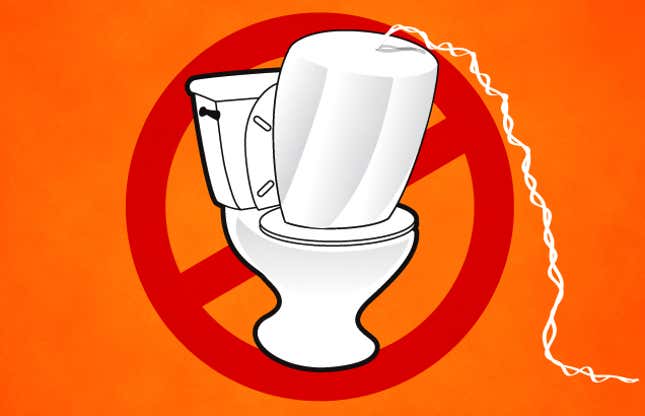Time to Accept Reality and Stop Flushing Tampons Down the Toilet
Latest

I know, we thought we had it so good for so long, but as the saying goes, all good things must come to an end. Or in this case, all that stuff you thought was OK to dump in the toilet, AKA the Get Rid of It Bowl, was, in fact, not OK after all. You know who you are.
Surprisingly, there’s a lot of misconception about what can go bye-bye down the toilet, like wipes, paper towels, condoms, drugs. None of those things are OK to flush, for the record. Zero! None! If the thing itself is made to stick together super well when wet, just say no. But when it comes to tampons, there’s a longstanding misconception that somehow, because these things are cotton-ish, they are kosher for flushin’. It should be an inalienable right, but as of this writing, it is still not a very good idea. This flushability lie begins with the manufacturer, manifests in the user, and results in a problem for the wastewater treatment systems, the environment, homeowners, and is a boon for plumbers everywhere (this is even more true of wipes, but that’s another headache).
Let’s examine the misconceptions.
Tampons should be OK to flush because they are cotton, and they are designed to break down — right?
“They don’t break down,” says Robert A. Villée, Executive Director of the Plainfield Area Regional Sewerage Authority in New Jersey. “Eventually, they will — they have some natural fibers in them that will break down. But they don’t break down in seconds like toilet paper, which breaks down as soon as you get it wet.” (This handy video demonstrates that premise exactly.)
Villée, who has been in the industry for over three decades, has seen some crazy stuff flushed down the toilet. (“One day, I saw a watch, a goldfish, a $20 bill, and some pot.”) He says feminine care products are about 18 percent of the material that shows up in the forensic testing he’s done on the stuff that comes through.
But the products say they are flushable, right on the box!
Villée says a huge part of the problem is that “manufacturers don’t make it very clear on the packaging what the disposal methods are. I have boxes of everything sitting down in my office. Now it might say somewhere in there in tiny text do not flush or dispose of in the trash, but it’s not very clear.”
This Playtex Tampons first-time-user guide clearly makes it seem like a matter of choice. After removing it, the website instructs, you can “Flush the used tampon or place in an appropriate waste container.” Tampax’s site says to “dispose into a trash can.”
-

-

-

-

-

-

-

-

-

-

-

-

-

-

-

-

-

-

-

-

-

-

-

-

-

-

-

-

-

-

-

-

-

-

-

-

-

-

-

-








































